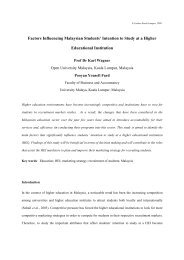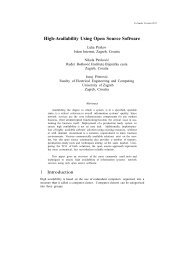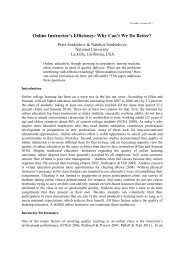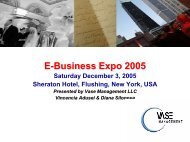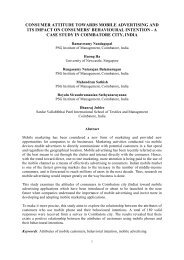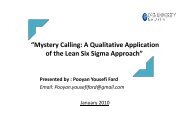download PDF - CASA
download PDF - CASA
download PDF - CASA
You also want an ePaper? Increase the reach of your titles
YUMPU automatically turns print PDFs into web optimized ePapers that Google loves.
„Business Business Wargaming“<br />
Wargaming<br />
A New Approach to Strategy Development and Learning?<br />
Kuala Lumpur, January 2009<br />
Dr. Daniel F. Oriesek
One thought to start off…<br />
Impossibility Theorem<br />
"One thing a person cannot do, no matter<br />
how rigorous his analysis or heroic his<br />
imagination, is to draw up a list of things that<br />
would ld never occur tto<br />
him."<br />
Th Thomas SSchelling h lli<br />
A.T. Kearney 16/05.2008/20144m<br />
2
OOver the th last l t months, th we saw massive i and d little littl anticipated ti i t d<br />
changes in the business environment!<br />
Selection of Symptoms<br />
Major shifts in the banking, insurance and pension-plan landscape<br />
IIncreasing i national ti l debts d bt and d iinfluence fl<br />
Liquidity constraints paired with higher risk premiums<br />
Roller-coasting raw material prices<br />
Capital expenditures are either moved back or cancelled all together<br />
Smaller budgets and degrees of freedom<br />
General insecurity – consumption is on the decline<br />
Recession in several economies – increasing unemployment<br />
Higher g factor volatility y + unexpected p events Higher g Insecurityy<br />
A.T. Kearney 16/05.2008/20144m<br />
3
While most companies see the value of strategic planning,<br />
28% consider the current tools as insufficient.<br />
Assessment of relevance and efficiency of strategic planning<br />
(in %)<br />
100% 100%<br />
5%<br />
2%<br />
40%<br />
55%<br />
St Strategic t i Planning Pl i is i Critical C iti l for f Company‘s<br />
C ‘<br />
Success<br />
Do not agree Do less agree Do agree Fully agree<br />
Quelle: A.T. Kearney Swiss Strategic Planning Benchmark Studie 2008<br />
26%<br />
52%<br />
19%<br />
CCurrent t St Strategic t i Planning Pl i Tools T l are Sufficient S ffi i t<br />
A.T. Kearney 16/05.2008/20144m<br />
6
40% of companies integrate future-focused future focused methodologies<br />
into their strategic planning process.<br />
Integration of future-focused methodologies<br />
100% 100% 100% 100%<br />
21% 33% 52% 83%<br />
79%<br />
48%<br />
31%<br />
Scenario<br />
Planning<br />
67%<br />
50%<br />
17%<br />
Future<br />
Workshops<br />
48%<br />
38%<br />
17%<br />
10%<br />
0%<br />
Expert<br />
Opinions<br />
(e.g.<br />
Delphi)<br />
Integrated Applied on an ad hoc basis<br />
17%<br />
Business<br />
Wargaming<br />
Not used<br />
Quelle: A.T. Kearney Swiss Strategic Planning Benchmark Studie 2008<br />
Applied on an<br />
ad hoc basis<br />
55%<br />
Not used<br />
5%<br />
Fully<br />
I t t d<br />
40% Integrated<br />
A.T. Kearney 16/05.2008/20144m<br />
7
But even when using g scenarios, , some major j deficits still<br />
remain.<br />
Classic<br />
Analysis<br />
Scenario<br />
Planning<br />
Advantages Shortfalls<br />
• Helps understand past trends and<br />
developments<br />
• Helps reach assumptions about the<br />
future based on the past(Extrapolation)<br />
• Helps to think in alternatives and assign<br />
them probabilities<br />
p<br />
• Helps to develop a comprehensive and<br />
interlinked strategy<br />
Deficits<br />
• The data lies in the past and do not offer<br />
insights into the future<br />
• Disruptive changes (e.g. new business<br />
models) can not be captured<br />
• Scenarios are rational and safe<br />
expansions p of the ppast<br />
• Scenarios are „black and white” – the<br />
reality includes many gray tones<br />
• Scenarios are biased by the people,<br />
who develop them<br />
• Lack of future-orientation<br />
• Confined by the boundaries of the scenarios<br />
• Limited contingency planning in the case of abrupt or disruptive changes<br />
• Lack of buy in and support of management (only limited involvement during development)<br />
A.T. Kearney 16/05.2008/20144m<br />
8
Let aside that many y companies p do not use the full potential p<br />
of working with scenarios.<br />
Use of Entry Probabilities<br />
(in %)<br />
100%<br />
Not used 21%<br />
Used on ad hoc basis 48%<br />
Fully integrated<br />
31%<br />
100% 79%<br />
Scenario planning Total No assessment/ Assessment/<br />
as part of planning<br />
calculation of entry calculation of entry<br />
process probabilities probabilities<br />
Quelle: Swiss Strategic Planning Benchmark Studie, A.T. Kearney<br />
21%<br />
A.T. Kearney 16/05.2008/20144m<br />
9
Business Wargaming leverages traditional strategic<br />
planning process by adding one important step.<br />
Assessment of Strategy<br />
Choosing a<br />
Testing the<br />
Strategic Variables Development Strategy<br />
Selected Strategy<br />
Potential<br />
Discontinuities<br />
History & Trends<br />
Foreseeable<br />
Developments<br />
Formulation of<br />
Strategic<br />
Objectives<br />
Analysis/<br />
Scenario<br />
Development<br />
Developing<br />
Strategic Options<br />
Critical<br />
Development of<br />
Uncertainties<br />
Strategic Plans<br />
Traditional Strategic<br />
Planning Stops here!<br />
Choice<br />
of a<br />
Plan<br />
Lessons Learned<br />
(Basis for Adjustments)<br />
Business Wargaming<br />
(Test)<br />
Discontinuities &<br />
Frictions<br />
(Re-)Actions of<br />
Competitors<br />
Regulatory<br />
Actions<br />
Surprises<br />
A.T. Kearney 16/05.2008/20144m<br />
10
Business Wargaming – also called dynamic strategy<br />
simulations – originated in the military<br />
Approx Approx. 3000 B.C. B C First wargame in China called “Wei Wei-Hai Hai”<br />
Approx. 2200 B.C. Development of strategy game “Go”<br />
Approx Approx. 500 Development of “Chaturanga” Chaturanga in India<br />
Approx. 13th Cent. First mention of “Chess” in Southern Europe<br />
1664 “Königsspiel” Königsspiel by Weikham as educational tool<br />
1780 Helwig develops game with figures, territory, referee<br />
1790 Clerk develops p simulation for naval battles<br />
End of 18th Cent. Venturini develops simulation for military training<br />
18th Cent. Extensive simulations by von Schanhorst during the<br />
liberation wars against Napoleon<br />
Since then Continuous enhancement and application<br />
A.T. Kearney 16/05.2008/20144m<br />
11
Why Business Wargaming?<br />
Better understand the forces at work in the marketplace and how they affect the business<br />
PProvide id ttop managers with ith experience i competitors tit llack k<br />
Gain the buy-in from top managers to act on this understanding and experience<br />
• Buy-in comes from confidence in assumptions and potential outcomes<br />
• Confidence comes from looking forward and responding to the potential discontinuities and<br />
surprises a company might face in the future marketplace<br />
A.T. Kearney 16/05.2008/20144m<br />
12
Basic assumption is that the old rules don’t don t apply any more<br />
Hey they they’re re lighting their arrows! Can they do that?<br />
© 1997 Gary Larson<br />
A.T. Kearney 16/05.2008/20144m<br />
13
Business Wargaming allows to anticipate the dynamics in<br />
the corporate environment and to prepare accordingly...<br />
Business Wargaming is not ...<br />
• A business school game with a finite<br />
number of lessons to be learned<br />
• A computer p simulation with answers built<br />
into the system<br />
• An off-the-shelf product, which is modified<br />
for each client and sold over and over<br />
again<br />
Business Wargaming …<br />
• Starts on a blank sheet of paper<br />
• Is designed for each client anew<br />
• Answers specific questions<br />
• Combines human decision making with<br />
quantitative measures<br />
• Allows managers to test strategies in a<br />
dynamic environment and see what<br />
happens<br />
• Saves time, money and grief as it allows<br />
tto prepare for f the th “unforeseen”<br />
“ f ”<br />
A.T. Kearney 16/05.2008/20144m<br />
14
Wargaming is a powerful, risk risk-free free process for thinking<br />
about the future<br />
Players are likely to detect weaknesses or gaps in their own strategy<br />
NNew iinsights i ht are dderived i d concerning i already l d kknown and d not t ttotally t ll assessed d iissues<br />
Players understand possible competitor (re-)actions<br />
Players can prepare for unexpected events<br />
Players think creative about the future<br />
Players gain trust into the strategic plan<br />
Players Reduce risk<br />
Include management buy-in for future strategic plans<br />
A.T. Kearney 16/05.2008/20144m<br />
15
During a Wargame, Wargame managers take the role of their firm firm,<br />
their competitors, their customers and even the regulator.<br />
Team „Company"<br />
• Executes original g strategy gy<br />
• Makes adjustments based<br />
on reactions of market and<br />
competition<br />
Competitor Teams<br />
• Create offerings in the<br />
market<br />
• Forge or dissolve alliances<br />
• Manage profitability<br />
• Take preemptive of reactive<br />
actions<br />
Client<br />
Company<br />
Competitor A<br />
CCompetitor tit B<br />
Competitor C<br />
Offerings<br />
Financial Effect<br />
MMarket k t<br />
Market-<br />
Shares<br />
Control<br />
Illustrative<br />
Market Team<br />
• Reacts to the strategies g of<br />
the different competitors<br />
• Drives market dynamic<br />
• Judges attractiveness of<br />
offerings g<br />
Control Team<br />
• Structures/runs the game<br />
• Introduces external shocks<br />
• Monitoring and arbitration<br />
• Keeps track of model and<br />
quantitative variables<br />
• Plays all other market<br />
participants<br />
ti i t<br />
A.T. Kearney 16/05.2008/20144m<br />
16
Wargames are typically played out over 3 "Moves“, Moves ,<br />
simulating a certain period in time.<br />
2008 2011 2014 2020<br />
MOVE 1 MOVE 2 MOVE 3<br />
Outlook<br />
Outlook<br />
OOutlook tl k<br />
Illustrative<br />
A.T. Kearney 16/05.2008/20144m<br />
17
Typical questions that you can address using a wargaming<br />
approach:<br />
Industry Consolidation – No attractive partner left? What can I do?<br />
• Examples: Media, Telco, Automotive, Airlines<br />
Changes of Business Model – Loss of control over my market?<br />
• Examples: Pharma, PCs, Mobile Phones, Market Liberalization<br />
How can I win?<br />
• Examples: Technology Jumps, Product Introductions, Market Liberalization<br />
How well am I prepared?<br />
• Examples: Different Events, Events (Financial-) (Financial ) Crisis Planning<br />
How do I make money in a commodity business?<br />
• Examples: Music distribution, Automotive, PCs, Mobile Phones, Energy, Chemicals<br />
How much is really necessary?<br />
• Examples: Weapon Systems, Star Wars/SDI<br />
Where is the next threat coming g from?<br />
• Example: Low-Cots Competitors, Global Shifts in Power, Terrorism<br />
A.T. Kearney 16/05.2008/20144m<br />
19
Business Wargaming can be applied for several different<br />
purposes and at different levels<br />
Testing strategies (Corporate, Business Unit, M&A)<br />
Ci Crisis i preparation ti<br />
Developing foresight<br />
Change Management<br />
Education and Recruiting<br />
Other possible fields are:<br />
• Reputation management (Corporate/National)<br />
• Strategic Early Warning Systems<br />
• Innovation-impulses (primarily on the product-level)<br />
A.T. Kearney 16/05.2008/20144m<br />
20
Case Examples<br />
A.T. Kearney 16/05.2008/20144m<br />
21
Changing Market Conditions<br />
Several Major Airlines<br />
Key<br />
questions<br />
• How strong can an airline be outside the major alliances?<br />
• What is the value of any secondary carrier? Can a secondary carrier operate without<br />
integration into a major alliance system?<br />
• How much control are you willing to give up in order to gain access to the routes and<br />
landing slots which are critical for your survival?<br />
• Wh Where are conditions diti ttaking ki th the airline i li iindustry? d t ? IIs th the “h “hub b and d spoke” k ” system t th the ffuture, t<br />
or will some other business model emerge?<br />
• The business model for air travel has fundamentally changed<br />
• PPast t – national ti l airlines i li hhave bbeen iin partnership t hi with ith national ti l governments t<br />
• Today – cheap air travel is a basic fight; the public asks for low priced, reliable<br />
services and frequent connections to major hubs<br />
Key • An existence outside powerful alliances is difficult<br />
Learnings • There is no apparent solution sol tion to combine of ccustomers stomers demand for lo low-priced priced air travel tra el with ith<br />
the ambition to remain as an independent national carrier<br />
• No other routes have more travelers, more growth and profit than the transatlantic routes<br />
• The control of the home market depends primarily on the ability to feed enough passengers<br />
to the north Atlantic routes<br />
A.T. Kearney 16/05.2008/20144m<br />
22
Market launch new technology<br />
Large European mobile operator<br />
Key y<br />
questions<br />
Key<br />
LLearnings i<br />
Results<br />
• What are the opportunities in mobile data?<br />
• Wh What t are th the success ffactors t ffor a successful f l positioning iti i and d hhow can thi this position iti be b<br />
defended?<br />
• It is not so much about technology, but rather what technology allows you to do<br />
• The handset is a key success factor<br />
• Less is more. Rather the right features as everything in one device. The market is limited in<br />
its capacity to absorb new features<br />
• There was no “killer-application” killer application like SMS for 3G mobile<br />
• The right combination of hardware, software, and access to content will bring success<br />
• Content partnerships are very important<br />
• Mobile network operators are at a danger of becoming pure commodity providers<br />
• A simplification of the price structure was urgently needed (flat rate model)<br />
• The company had a solid strategy for the consumer segment, while the potential in the<br />
business segment was underestimated and not sufficiently addressed<br />
• The company addressed the threat though commoditization by executing targeted content<br />
and portal strategies<br />
A.T. Kearney 16/05.2008/20144m<br />
23
Key Account Management<br />
Fast Moving Consumer Goods Company (White-Label)<br />
(White Label)<br />
• What are the key success factors to break into new key accounts?<br />
Key • How do I defend my position vs vs. aggressive competitors?<br />
Questions • How can I reach sustained product leadership by integrating suppliers and customers in<br />
my innovation process?<br />
Key<br />
Learnings<br />
• Success goes beyond the development and procuction of goods.<br />
• Competence and advice in category management are important differentiators, which help<br />
to establish entry barriers.<br />
• Other services such as labeling, legal clearance, logistics etc. are part of the value<br />
equation i<br />
• Integrated innovation processses help secure long-term procuct leadership.<br />
• The LOHAs movement is an important driver in the market going forward.<br />
Special Point:<br />
• A relatively young „Account Team“ had to compete against its predecessors, which had<br />
penetrated the account originally and since all have been promoted. They now played a<br />
formidable and experienced adversary trying to win the account back.<br />
A.T. Kearney 16/05.2008/20144m<br />
24
Development of the Portable Audio Market<br />
Recruiting Game at top business schools (The CEO Challenge)<br />
Key y<br />
Questions<br />
Key<br />
Learnings<br />
• How will the market for portable audio devices develop?<br />
• Can Apple defend defend, expand it‘s it s dominant market position?<br />
• What will the devices of the future look like?<br />
• Apple will be able to successfully and profitably defend its position.<br />
• The biggest threat for Apple is not coming from portable audio device manufacturers, but<br />
mobile phone manufacturers.<br />
• Trend towards simple user interfaces (software GUI instead of many buttons)<br />
• Trend towards hybrid devices (phone and audio players) Prediction of iPhone<br />
• Believed-to-be-dead brands will be reactivated; e.g. Sony Ericsson with the new-old<br />
"Walkman“ logo<br />
• The right combination of hardware, software, and access to content will bring success<br />
A.T. Kearney 16/05.2008/20144m<br />
25
What happens at a CEO Challenge?<br />
30 students, from top business schools – come together to participate in a unique three day<br />
event<br />
They receive a crash course in strategy development and business wargaming, the industry<br />
to be simulated as well the specifics of the simulation<br />
The participants are broken into 5-6 smaller teams and they are lead by a team of 5-6 staff<br />
In these teams they create a vision and strategy for real companies reacting to ever<br />
changing market conditions or simulate the market<br />
Students also have the opportunity to interact with staff in casual settings<br />
A.T. Kearney 16/05.2008/20144m<br />
26
pictures from various events<br />
A.T. Kearney 16/05.2008/20144m<br />
27
Applications have risen sharply since the first event<br />
Number of applicants<br />
450<br />
400<br />
350<br />
300<br />
250<br />
200<br />
150<br />
100<br />
50 45<br />
0%<br />
160<br />
240<br />
450<br />
October 2004<br />
January 2005<br />
September 2005<br />
January 2006<br />
(one event only)<br />
(two events)<br />
(two events)<br />
(two events)<br />
A.T. Kearney 16/05.2008/20144m<br />
28
The major learning for participants came from the<br />
simulation itself<br />
60%<br />
50%<br />
40%<br />
30%<br />
20%<br />
10%<br />
0%<br />
Source: Participant Survey<br />
51%<br />
Which activity helped you best understand what a consultant does?<br />
52%<br />
25%<br />
16%<br />
20%<br />
19%<br />
4%<br />
Kellogg Event<br />
Harvard Event<br />
Simulation Informal Interaction<br />
Team<br />
Session/<br />
Discussions<br />
13%<br />
with Coaches Interaction<br />
A.T. Kearney 16/05.2008/20144m<br />
29
All participants p p agree g that the CEO challenge g is a truly y<br />
unique event<br />
Testimonials<br />
“Fantastic Fantastic - it really was an unforgettable<br />
experience.”<br />
“One of its kind”<br />
“The methodology is as close to real life<br />
as it gets”<br />
“It is very unique - especially in terms of<br />
exclusivity”<br />
“More More creative and informational informational. A<br />
genius idea really”<br />
Source: Participant Survey<br />
Testimonials<br />
“This This is definitely unique.” unique.<br />
Selection from<br />
all events<br />
“Very Unique. I have never even heard<br />
of an event like this. Very cool”<br />
“Very original - way to lead the pack!”<br />
“No other company has a similar event.<br />
Most of them are competitive.”<br />
“I haven’t seen wargaming before, so it is<br />
a unique and cool proposition proposition. This is<br />
much better than a case study”<br />
“Awesome! Nobody else does anything<br />
like this.”<br />
A.T. Kearney 16/05.2008/20144m<br />
30
Feedback of participants<br />
“We looked at us and the industry y<br />
through the eyes of our competitors<br />
and the marketplace. The world was<br />
really different and we began to<br />
understand why they sometimes<br />
didn’t do what we thought they<br />
might do.”<br />
”We were shocked... We learned a<br />
lot."<br />
”I have never understood why they<br />
never acted the way as we thought<br />
they would." would "<br />
Selection<br />
“We are now making our decisions<br />
quicker, better coordinated and a<br />
whole lot smarter”.<br />
”One sale - which would have been<br />
lost previously - played for this<br />
simulation." (CEO)<br />
A.T. Kearney 16/05.2008/20144m<br />
33
If you would like to know more about this topic, please<br />
have a look at our new book…<br />
Business Wargaming<br />
Securing Corporate Value<br />
Daniel F. Oriesek & Jan Oliver Schwarz<br />
Gower Publishing Limited - Hampshire, ISBN-13: 978-0-566-08837-7<br />
Published in August g 2008.<br />
A.T. Kearney 16/05.2008/20144m<br />
34
Questions?<br />
A.T. Kearney 16/05.2008/20144m<br />
35
Contact<br />
Contact details<br />
Dr. Daniel F. Oriesek<br />
A.T. Kearney (International) AG, Schweiz<br />
Renggerstrasse 3, 8038 Zürich<br />
Phone: +41 44 487 44 00<br />
Fax: +41 44 487 44 99<br />
Mobile: +41 79 457 57 71<br />
MMail: il daniel.oriesek@atkearney.com<br />
d i l i k@ tk<br />
A.T. Kearney 16/05.2008/20144m<br />
36


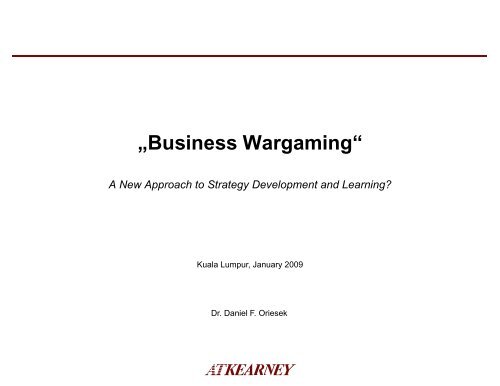
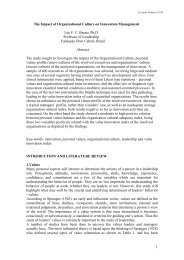
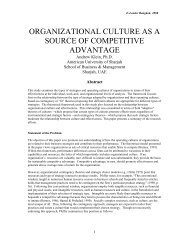
![Oberholzer [Compatibility Mode].pdf - CASA](https://img.yumpu.com/21081507/1/190x135/oberholzer-compatibility-modepdf-casa.jpg?quality=85)


